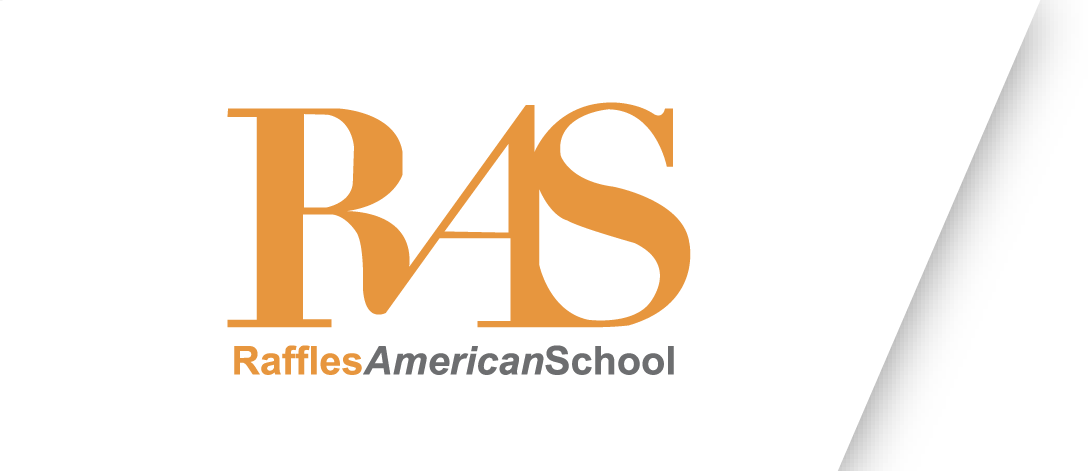Why Technology Matters in Your Child’s Elementary Education
February 7, 2025
As parents, we want to ensure that our children have the best opportunities to succeed and find happiness in an ever-changing world. The path to success and happiness can sometimes feel less clear with the global introduction of digital technologies in many areas of our lives. Studies show that children who learn with technology early develop stronger problem-solving skills, creativity, and teamwork abilities (Warschauer & Matuchniak, 2010). The thoughtful and proactive strategy of technology integration at RAS helps guide students toward building a balance of reaching academic and interpersonal goals.
Building Digital Smarts: Consumption vs Creation
It is crucial that by the end of elementary school, students have a solid foundation of choosing and using tools that can help them reach their academic goals but can also think critically about how technology might be distracting them from their goals. At Raffles American School, we help shift students’ mindsets from viewing technology as a consumption tool to help them see it as a tool that can help them clarify and communicate their ideas creatively.
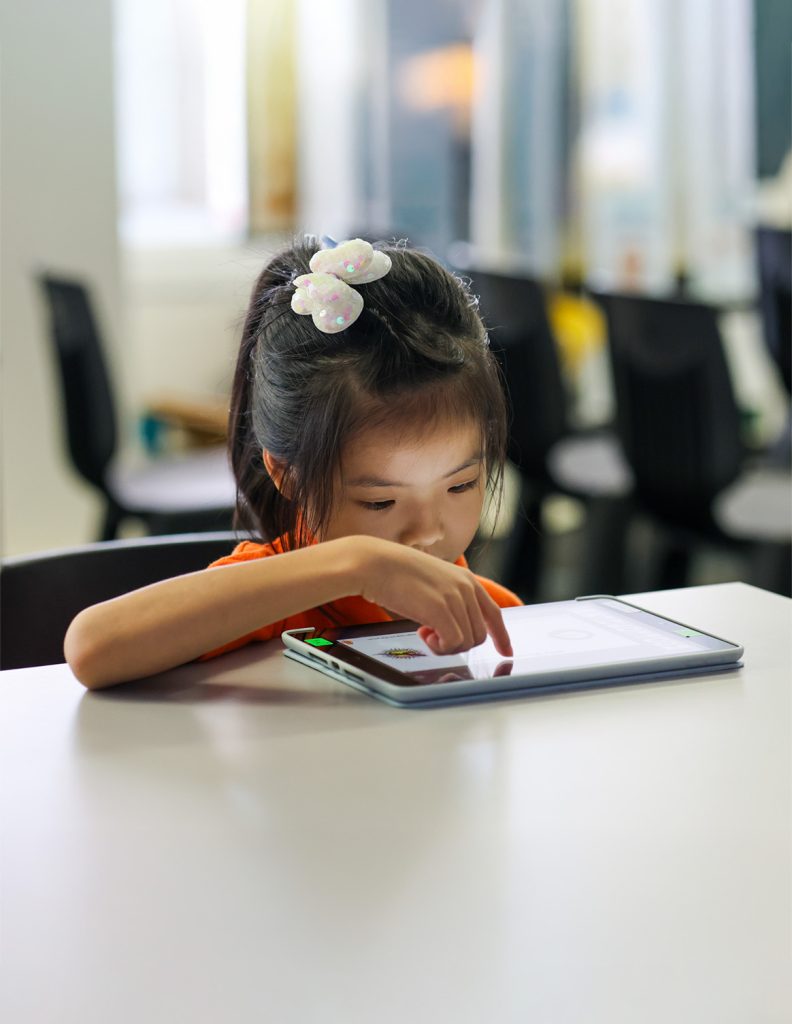
Preparing Students for an Ever-Changing Future.
How do we prepare students for a future that is less predictable than previous generations? RAS Elementary School is closely aligned with the International Society of Technology and Education (ISTE) as the backbone of our technology integration plans. The seven ISTE student standards help prepare students to use technology thoughtfully to support them as they pursue academic skills and a healthy mindset for navigating their social world. The ISTE standards also support our GLOs at RAS to help students think critically, find trustworthy information online, and use digital tools responsibly. Children exposed to technology early are better prepared to navigate today’s digital world (Crompton & Burke, 2016). Teaching them about their digital footprint and other elements of Google’s Be Internet Awesome framework also helps them use the internet safely and respectfully to safeguard them in the future.
Making Learning Fun, Reflective and Personalized
At Raffles American School, we believe that every child learns differently, and technology helps teachers meet those unique needs. Technology also allows teachers to personalize learning and help students personalize their research when completing projects. Research shows personalized learning—where kids get lessons tailored to their abilities—can boost their confidence and improve their grades (Herold, 2016).
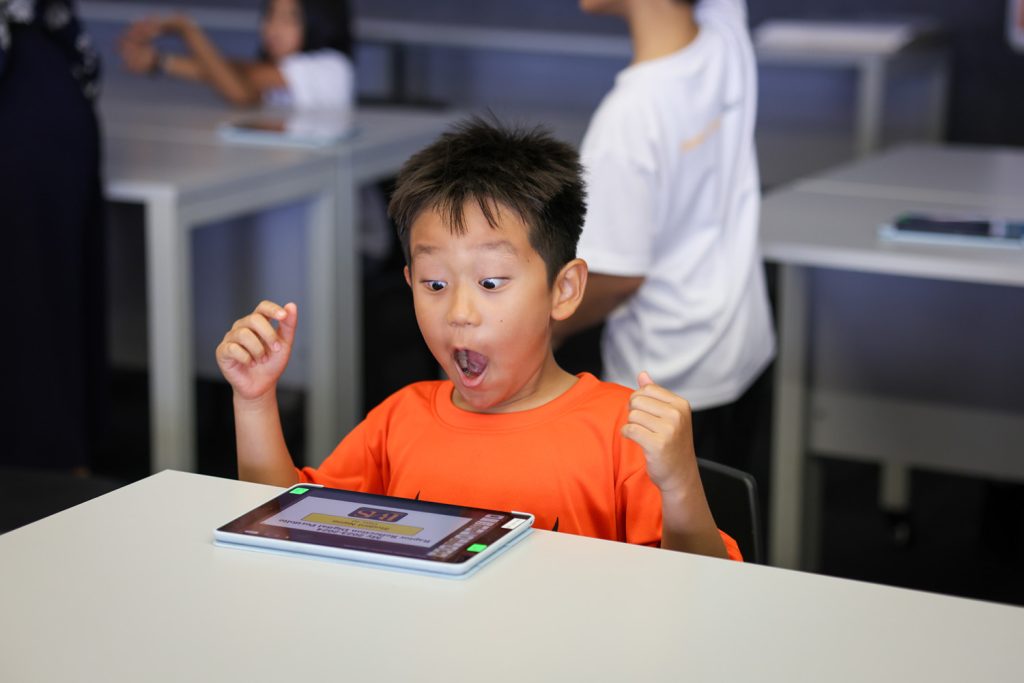
Beginning this school year, All students from grade 2 through grade 5 create their own digital portfolio throughout the year. These interactive multimedia portfolios were co-created with homeroom teachers and specialist teachers to act as a reflective learning journey for students to showcase the projects that resonated with them – and what they learned from the process. These portfolios bring together images or videos of their work as they follow guiding questions by talking and typing as they reflect upon their learning.
RAS Elementary has selected a handful of platforms to help teachers provide personalized learning paths. Beyond our MAP and WIDA tests, Tools like Zearn, IXL Prodigy, 99Math, RazKids, etc. allow teachers to use data to provide a customized learning path which provides students with personalized learning opportunities at their current level so that all students can make progress towards the classrooms’ shared learning goal. We have chosen these tools because they offer the right level of gamification and storytelling elements. Moreover, they “promote student engagement” (Parker, Thomsen and Berry, 2022) via learning through playand help students have fun while learning, and the student progress is serious and measurable. Students do not use technology to play games on campus, but we do create engaging templates in the Elementary school to help students interact with and personalize their learning materials.
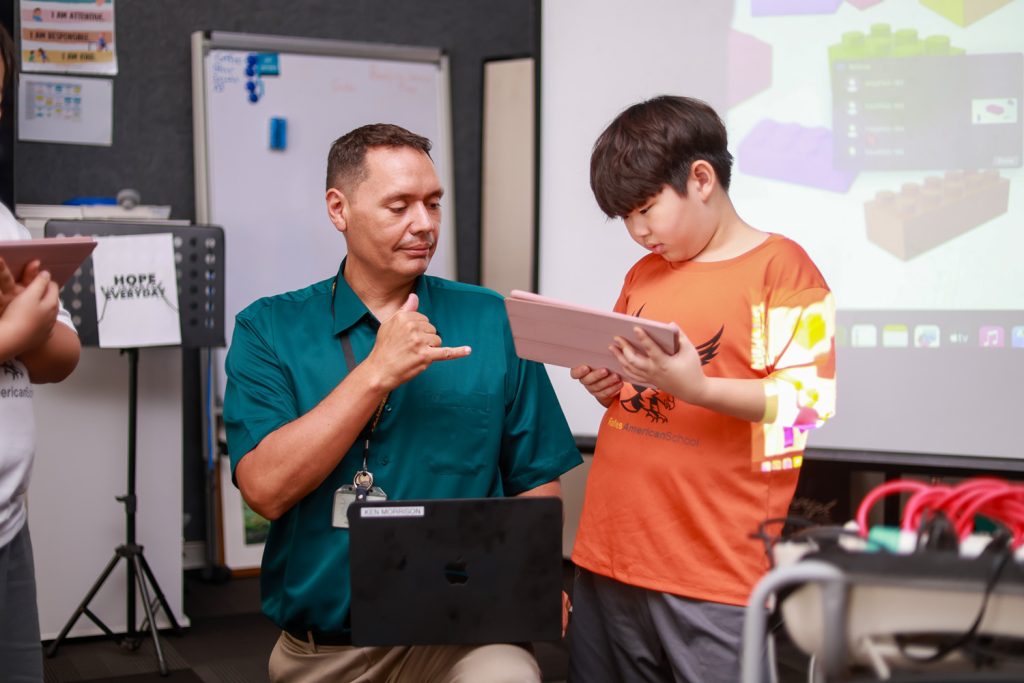
Personalized Voice, Choice and Feedback
As early as Grade 2, students co-create goals with their teacher after receiving scores from their MAP tests. RAS students and teachers use IXL and other tools to help customize a path to help students reach their goals. Student portfolios help students curate and showcase their favorite projects in a multimedia format which they can be proud of.
Balancing Technology with Traditional Learning
The research underscores the importance of balancing technology with traditional pen-and-paper learning in education. Handwriting plays a crucial role in developing fine motor skills, enhancing memory, and fostering a deeper connection to the material. Studies have shown that writing by hand engages different brain areas and stimulates neural pathways, which can lead to improved learning outcomes. (Warrior,
2023). In our Technology and Design classes, students are often encouraged to think, talk, and take notes on paper to clarify thinking before using technology.
Furthermore, handwriting instruction during early education can improve both writing and reading outcomes, such as knowledge of letter names and sounds, spelling, and word recognition (Datchuk, 2024). Seeing students apply their UFLI phonics skills on paper helps teachers identify and correct spelling progress and give prompt and personalized feedback. This is much more powerful than using autocorrect on a device.
Integrating both traditional and technological methods in the classroom ensures that children develop a comprehensive skill set, preparing them for various challenges. This balanced approach allows students to utilize the appropriate tools for different tasks, enhancing their overall learning experience. (Viola, 2019)
Our Elementary School-wide writing prompts are non-digital, so teachers can see authentic writing from students. By combining the strengths of both traditional handwriting and modern technology, educators can create an effective and engaging learning environment for students.
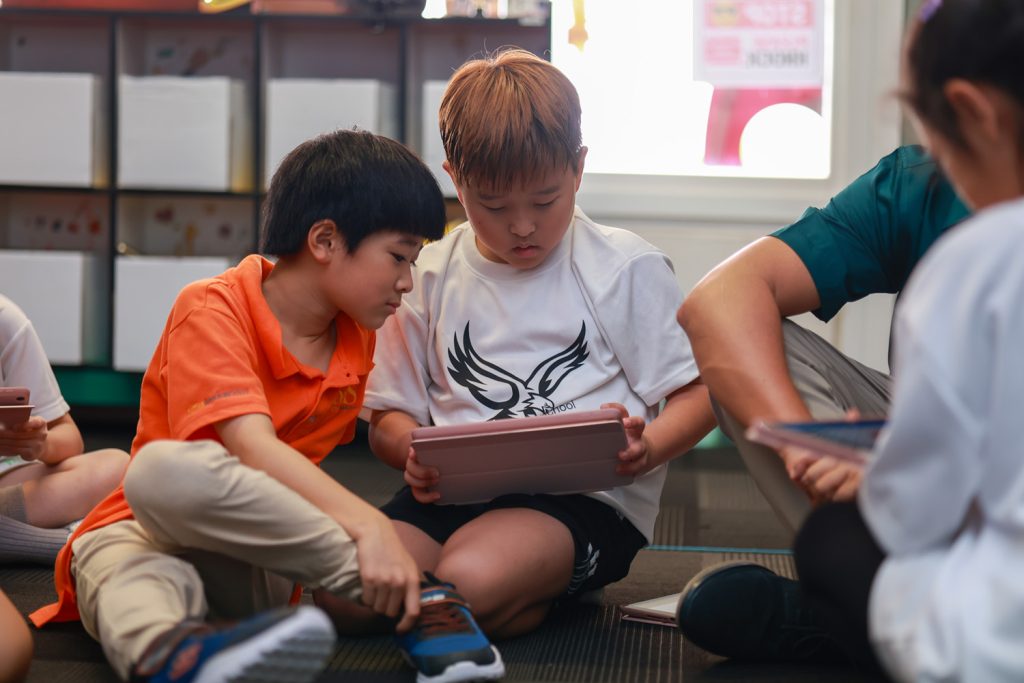
Learning to Work as a Team
Technology helps children learn how to work together, just like they’ll need to in the real world. The RAS GLOs are tied to instruction and guidance for students before unlocking permission to use Gmail and Google Education tools in Grade 2 and throughout their learning journey. As early as Grade 3, students learn some of the advanced collaboration tools embedded in Google Docs and collaborate on Google Slide through appropriate digital comments as they share ideas and solve problems as a group.
Furthermore, research shows that working with others using technology builds better communication and teamwork skills (Roschelle et al., 2000). In Apple Clips Club, each student knows that they will have a speaking prompt each week before anyone touches their iPads. Students are also required to ask follow-up questions to the speaker before the next student can present. This helps students realize the importance of building relationships as a team before building skills with technology.
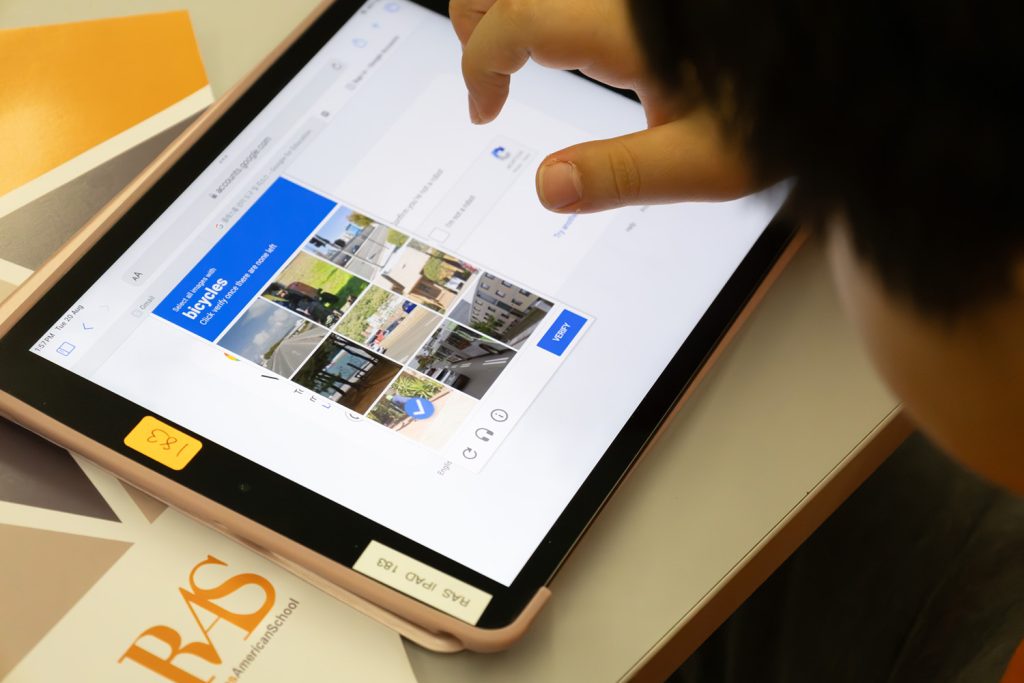
Apple Education Creativity Tools
Collaboration and creativity are baked into Apple’s free education and productivity tools. Although students use Keynote, they know that it is much more than a Presentation tool. Students at RAS Elementary School use Keynote as an interactive multimedia workspace that allows them to express their ideas with images, text, video, animation, and voice recordings. With the help of custom-made templates created by their teachers, students can showcase their past work and advocate for their progress toward classroom learning goals.
Students also use Apple Clips to reflect on their learning. By using LiveType within Apple Clips, students get immediate feedback on their pronunciation. Because this tool is not connected to the internet, students can express their personality and creativity while learning without being concerned over whether strangers are seeing their videos. Clips is a great tool for teachers to activate prior knowledge, storytelling to get students’ attention, and showcasing student work. In a recent technology class, Mr. Ken Morrison had his students create a video based on the dioramas they completed in their Homeroom science classes. (click on this link to see the video). Studies suggest that when kids use multimedia tools like Apple Clips, they remember and understand their lessons better (Mayer, 2009). Plus, it’s a fun way for them to express themselves and learn new technical skills.
Preparing for Their Future
Technology isn’t just about learning for today; it’s about preparing for tomorrow. By 2025, most jobs will require advanced digital skills (World Economic Forum, 2020). Starting early helps children build the confidence and adaptability they need to thrive in a tech-driven world.
Some upcoming units include the coding and computational thinking projects as well as a keystone collaboration project between Grade 4 and Grade 5. This will be our third year of this unique collaboration. Older students will collaborate among Homerooms to use Apple creativity tools to share what they learn from Google’s “Be Internet Awesome” child safety resources. These collaborative projects will be shared with all elementary students via face-to-face presentations as well as saved on all RAS iPads so all students can refer to these student tips throughout the school year!
Through the ISTE standards, the RAS GLOs, our Elementary School Technology guidelines, and the caring guidance of our teachers, we are helping students prepare for a digital future while caring for the whole child. We aim to maintain, enhance, and encourage creativity both with and without technology. We want students to remember the golden rule of our technology agreement that “People are more important than technology” and that technology helps students strive in the classroom when they keep caring, keep safe, keep learning, keep original and keep balanced.
As parents, we want our kids to have every advantage. By embracing technology in their education, we’re giving them tools to succeed, explore their creativity, and grow into lifelong learners ready for the future. Think of technology and traditional learning as two wheels of a bicycle—each one plays an essential role, and together, they move your child forward toward a brighter future.
References
- Crompton, H., Burke, D. The Nexus of ISTE Standards and Academic Progress: A Mapping Analysis of Empirical Studies. TechTrends (2024). https://doi.org/10.1007/s11528-024-00973-y
- Datchuk, S (2024) Handwriting is beneficial for reading and often misunderstood. Retrieved from https://irrc.education.uiowa.edu/blog/2024/07/handwriting-beneficial-reading-and-often-misunderstood
- Herold, B. (2016) ‘Personalized Learning: What Does the Research Say?’, Education Week, 19 October. Available at: https://www.edweek.org/technology/personalized-learning-what-does-the-research-say/2016/10.
- Mayer, R. E. (2009). Multimedia learning (2nd ed.). Cambridge University Press. https://doi.org/10.1017/CBO9780511811678
- Parker, R., Thomsen, B.S. and Berry, A. (2022) ‘Learning through Play at School – a Framework for Policy and Practice’, Frontiers in Education, 7(1). Available at: https://doi.org/10.3389/feduc.2022.751801.
- Roschelle, J., et al. (2000). “Changing How and What Children Learn in School with Computer-Based Technologies.” The Future of Children. Available at: https://pubmed.ncbi.nlm.nih.gov/11255710/
- Warschauer, M., & Matuchniak, T. (2010). “New Technology and Digital Worlds: Analyzing Evidence of Equity in Access, Use, and Outcomes.” Review of Research in Education. Available at: https://journals.sagepub.com/doi/10.3102/0091732X09349791
- Warrior, P (2023). The impact of handwriting on learning and memory. Retrieved from https://penvibe.com/the-impact-of-handwriting-on-learning-and-memory
- World Economic Forum (WEF). (2020). “The Future of Jobs Report.” WEF Publications. Available at: https://www.weforum.org/publications/the-future-of-jobs-report-2020/
Viola, J. (2019 The role of technology in teaching reading, writing, and maths. Retrieved from https://theeducationhub.org.nz/the-role-of-technology-in-teaching-reading-writing-and-maths
